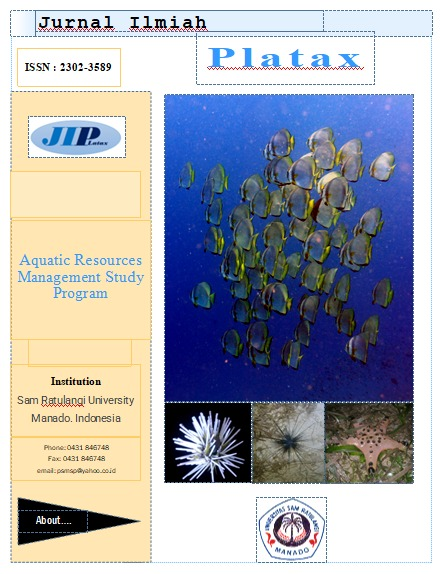Comparison of Tidal Analysis Results at Tumumpa Coastal Fishing Port Using Least Squares Method and Admiralty Method
DOI:
https://doi.org/10.35800/jip.v10i1.36887Keywords:
Tides, Formzahl, RMSE, PPP TumumpaAbstract
Tumumpa Coastal Fishing Port is located at 1°31'21"-1°31'35" N, 124°50'28"-124°51'24" E Tides are one of the phenomena that can be utilized as a reference in determining natural resource management policies and as a supplement to data used to forecast future marine conditions. Using the Least Squares Method and the Admiralty Method with 15 days of observation data, the analysis was undertaken with the goal of finding the phase and amplitude of tidal components, type of tides, and the elevation of sea level at  Tumumpa Coastal Fishing Port. The tidal type  at the port is mixed semidiurnal tides, the formzahl value for the least square method is 0.48, while for the Admiralty method is 0.39
Keywords: Tides; Formzahl; RMSE; PPP Tumumpa.
Abstrak
Pasang surut air laut merupakan salah satu fenomena yang bisa dijadikan referensi dalam penentuan kebijakan untuk pengelolaan sumber daya alam dan sebagai data pelengkap untuk menggambarkan kondisi laut pada masa mendatang. Tujuan dari penelitian ini adalah untuk menganalisis komponen-komponen pasang surut dan tipe pasang surut yang diukur di Pelabuhan Perikanan Pantai (PPP) Tumumpa. Analisis dengan menggunakan metode kuadrat terkecil dan metode Admiralty berdasarkan data 15 hari pengamatan. Hasil penelitian menunjukkan bahwa tipe pasang surut di PPP Tumumpa bertipe campuran condong harian ganda. Didapatkan dominasi komponen harmonik pasang surut pada PPP Tumumpa, bertipe campuran condong harian ganda. Komponen harmonik pasang surut dominan di  PPP Tumumpa, yaitu komponen semidiurnal untuk metode kuadrat terkecil M2 = 0.21 dan S2= 1.47 sedangkan untuk metode Admiralty M2 = 52.08 dan S2= 34.59.
Kata kunci:Â Pasang surut; Nilai Formzahl; RMSE; PPP Tumump
References
Dronkers, J. J. (1964). Tidal Computations in Rivers and Coastal Waters. North-Holland Publishing Company. Amsterdam.
Gracella. (2019). Uji Kualitas Hasil Analisa Perbandingan Prediksi Pasang Surut Metode Admiralty Dan Meode Least Square [Skripsi]. Malang: Teknik Geodesi, Institut Teknologi Nasional Malang, 60 hal.
Gumelar, J., Sasmito, B., & Amarrohman, F. J. (2016). Analisis Harmonik dengan menggunakan teknik kuadrat terkecil untuk penentuan komponen-komponen pasut di wilayah Laut Selatan Pulau Jawa Dari satelit altimetri Topex/Poseidon dan Jason-1. Jurnal Geodesi Undip, 5(1), 194-203.
Guntara, O., Handoyo, G., & Marwoto, J. (2017). Peramalan Pasang Surut Di Pelabuhan Perikanan Pantai Teluk Saleh Sumbawa. Journal of Oceanography, 6(4), 616-624.
Hasanudin, M., Kusmanto, E., & Budisetyawan, W. (2016). Amplifikasi pasang surut dan dampaknya terhadap perairan pesisir Probolinggo. OLDI (Oseanologi dan Limnologi di Indonesia), 1(3), 69-80.
Ingham, A. E. (1974). Sea Surveying. John Wiley and Son. Brent Wood
Kementerian Kelautan dan Perikanan. (2020). Diakses Juni, jdih.kkp.go.id, https://jdih.kkp.go.id/bahanrapat/bahanrapat_16072020172530.pdf
Khusuma, F. H. (2008). Analisis Harmonik dengan Menggunakan Teknik Kuadrat Terkecil untuk Penentuan Komponen-komponen Pasut di Perairan Dangkal dari Data Topex/Poseidon. Program Studi Teknik Geodesi dan Geomatika Fakultas Ilmu dan Teknologi Kebumian Institut Teknologi Bandung. Bandung.
Nazir, M. (2003). Metode Penelitian. Jakarta: Ghalia Indonesia.
Poerbandono dan Djunarsjah, E. (2005). Survey Hidrografi. PT Refika Aditama, Bandung, 166 hal. Prayogo, LM (2020). Perbandingan Metode Admiralty dan Least Square untuk Analisis Pasang
Surut di Pulau Mandangin Kabupaten Sampang, Jawa Timur (Comparison of …. Jurnal Perikanan dan Kelutan p–ISSN, researchgate.net.
Salnuddin, S, Nurjaya, IW, Jaya, I. (2018). Amplitude Variations of Tidal Harmonic Constituents in Bitung Station (Variasi Amplitudo Konstituen Harmonik Pasang Surut Utama di Stasiun Bitung).
Triatmodjo, B (2014). Perencanaan bangunan pantai., repo.unikadelasalle.ac.id, http://repo.unikadelasalle.ac.id/index.php?p=show_detail&id=9669&keywords=
Downloads
Published
How to Cite
Issue
Section
License
COPYRIGHT
Authors who publish with this journal agree to the following terms:
Authors hold their copyright and grant this journal the privilege of first publication, with the work simultaneously licensed under a Creative Commons Attribution License that permits others to impart the work with an acknowledgment of the work's origin and initial publication by this journal.
Authors can enter into separate or additional contractual arrangements for the non-exclusive distribution of the journal's published version of the work (for example, post it to an institutional repository or publish it in a book), with an acknowledgment of its underlying publication in this journal.
Authors are permitted and encouraged to post their work online (for example, in institutional repositories or on their website) as it can lead to productive exchanges, as well as earlier and greater citation of the published work (See The Effect of Open Access).




















